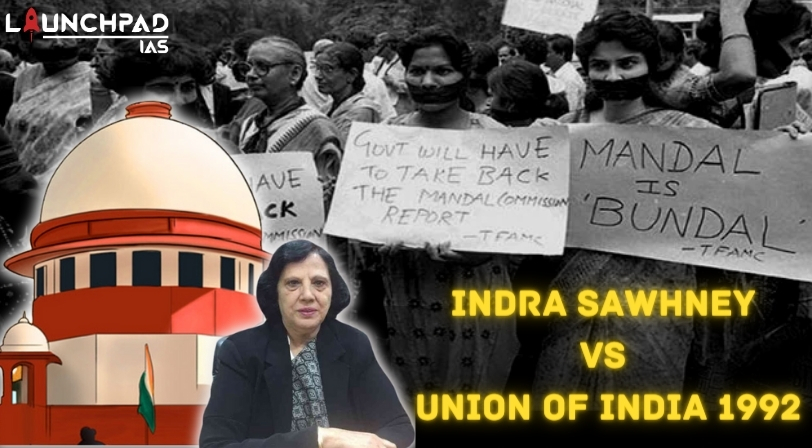About
- In 1979, the Second Backward Classes Commission (Mandal Commission) was set up.
- It was tasked to determine the criteria for defining the socially and educationally backward classes.
- The Mandal report identified 52% of the population at that time as “Socially and Economically Backward Classes” (SEBCs).
- It thus recommended 27% reservation for SEBCs.
- This was in addition to the previously existing 22.5% reservation for SC/STs.
- In 1990, the V P Singh-led government set out to implement the Mandal commission recommendations.
- This was challenged in court amidst widespread protests against the move.
- The Indra Sawhney case came up before a nine-judge Bench and a 6:3 verdict was delivered in 1992, popularly called the Indra Sawhney judgement.
What did the Indra Sawhney Ruling Say?
- The court upheld the office memorandums that essentially implemented the Mandal report.
- The executive orders mandating 27% reservation for backward castes were said to be valid.
- The reservation was made not just based on caste, even if it appears so.
- It is also made based on the objective evaluation of the social and educational backwardness of classes, which is the criterion previously laid down by the court.
- The landmark Indra Sawhney ruling set two important precedents.
- First, it said that the criteria for a group to qualify for reservation is “social and educational backwardness”.
- Additionally, the court also reiterated the 50% limit to vertical quotas it had set out in earlier judgements in 1963 (M R Balaji v State of Mysore) and in 1964 (Devadasan v Union of India).
- It reasoned that this was needed to ensure “efficiency” in administration.
- The court said this 50% limit will apply, unless in “exceptional circumstances”.
- The social and educational backwardness criteria stemmed from the interpretation of various constitutional provisions.
- However, the 50% limit is often criticized as being an arbitrary limit.
How does the Judgement Relate to the Maratha Reservation?
- There are two main constitutional questions for the court to consider in the challenge to the Martha quota law:
- whether states can declare a particular caste to be a socially and educationally backward class
- whether states can breach the 50% ceiling for “vertical quotas” set by the Supreme Court
- Notably, the 102nd Amendment to the Constitution gives the President the power to notify backward classes. The court will have to look into whether states have similar powers under this.
- Also, this power flows from the Constitution.
- The Court will thus have to see if the President is still required to comply with the criteria set by the Supreme Court in the Mandal case.
- The relevance of the Indra Sawhney criteria is also under question in another case in which the validity of the 103rd Amendment has been challenged.
- The 103rd Amendment, passed in 2019, provides for 10% reservation in government jobs and educational institutions for the economically weaker section in the unreserved category.
- Similar to the Maratha issue are the cases of Patels in Gujarat, Jats in Haryana, and Kapus in Andhra Pradesh.
- Additionally, with the implementation of the Maharashtra law, the vertical quota in the state could go up to 68%.
- This was 52% before the passing of the law.
- This aspect will also come under question.
- The Indra Sawhney verdict gives a pass to breach the 50% quota rule only in exceptional circumstances.
- The court will have to test if the Maharashtra law qualifies to be an exception.
- The potential reconsideration of the popular Indra Sawhney ruling could alter the structure of reservations that have been in place for decades.
Have Any Other States Breached the 50% Ceiling Before?
- States have breached the 50% ceiling before and intend to bring more reservations.
- A notable example is Tamil Nadu. Tamil Nadu Backward Classes, SCs and STs (Reservation of Seats in Educational Institutions and of Appointments or Posts in the Services under the State) Act, 1993
- The Act reserves 69% of the seats in colleges and jobs in the state government.
- However, this was done by amending the Constitution, to place the law in the Ninth Schedule after the Indra Sawhney judgment.
- The Ninth Schedule provides the law with a “safe harbour” from judicial review under Article 31A of the Constitution.
- Laws placed in the 9th Schedule cannot be challenged for reasons of violating any fundamental right protected under the Constitution.
- However, the Tamil Nadu law was challenged in 2007 (I R Coelho v State of Tamil Nadu).
- To this, the Supreme Court ruled in a unanimous 9-judge verdict.
- It said that while laws placed under the 9th Schedule cannot be challenged on the grounds of violation of fundamental rights, they can be challenged on the ground that they violate the basic structure of the Constitution.
- A later Bench was to decide whether the Tamil Nadu law itself (breaching the 50% ceiling) violates basic structure, based on the I R Coelho verdict.
- The Bench has not been set up yet.


